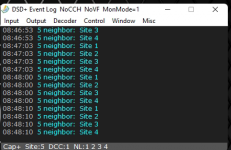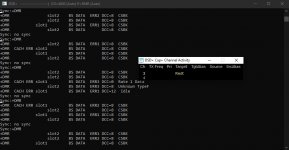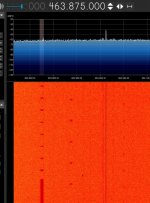My local hospital seems to have gone CAP+ and with what seems like encryption. Despite that I would like to map it out and add it here to the database.
1) How do I do that? (I'm thinking DSD+)
2) I've never monitored a CAP+ system before. Not a lot in the area. I use a 996P2 in the car. I guess it would be programmed as a trunked system in some way? Again, they seem encrypted because monitoring one frequency was dead silent on the scanner. The scanner would flash CAP+ however.
A lot of business trunked systems are fairly idle outside of normal business hours. To make it as easy as possible to map out one, you really want to try and do the monitoring at a time when the system/site is most active.
DSDPlus is one way to map it out (and in my mind the recommended way). On CAP+ systems, DSDplus (and scanners that support DMR trunking) are not going to determine the LCNs associated with the frequencies until voice calls (in-the-clear or encrypted) are heard. So you basically have to sit on the frequencies (usually the best would be the beaconing rest channel) and just wait for a voice call. If you were using DSDPlus and doing that, when a voice call occurs on _that_ frequency it is going to tell you what LCN is associated with that frequency.
If you are logging, which by default DSDPlus would be doing, you can find some info in the 1R-DSDplus.event file (which is just a text file).
Example:
2022/04/02 16:38:57 Freq=451.675000 Current site: 1
2022/04/02 16:39:00 Freq=451.675000 DCC=14 Enc TXI Group call; TG=52 RID=1133 Ch=2 Alg=BP
2022/04/02 16:39:00 Freq=451.675000 DCC=14 Group call; TG=52 Ch=1
2022/04/02 16:39:00 Freq=451.675000 DCC=14
451.675000 is first Cap+ repeater (Ch1 and Ch2)
2022/04/02 16:39:00 Freq=451.675000 DCC=14 Enc TXI Group call; TG=52 RID=1133 Ch=1 Alg=BP 5s
2022/04/02 16:39:05 Freq=451.675000 DCC=14 Enc TXI Group call; TG=52 RID=1161 Ch=1 Alg=BP 6s
2022/04/02 16:39:12 Freq=451.675000 DCC=14 Enc TXI Group call; TG=52 RID=1133 Ch=1 Alg=BP 3s
2022/04/02 16:39:15 Freq=451.675000 DCC=14 Enc TXI Group call; TG=52 RID=1161 Ch=1 Alg=BP 5s
2022/04/05 09:05:22 Freq=452.075000 Group call; TG=5 Ch=3 2s
2022/04/05 09:05:26 Freq=452.075000 DCC=1 Group call; TG=5 Ch=4
2022/04/05 09:05:26 Freq=452.075000 DCC=1 Group call; TG=5 RID=6008 Ch=4
2022/04/05 09:05:26 Freq=452.075000 DCC=1
452.075000 is second Cap+ repeater (Ch3 and Ch4)
So we we were parked on 451.675 just monitoring one particular frequency of one Cap+ site. When a voice call occurred, DSDPlus determined that 451.675 was the first Cap+ repeater (aka LCN 1).
And when we were parked on 452.07 monitoring a frequency from another Cap+ site, when a voice call occurred DSDPlus determined that 452.075 was the second Cap+ repeater (aka LCN 2).
LCN 1 (ch1 / ch2 in the Channel Activity Window)
LCN 2 (ch3 / ch4 in the Channel Activity Window)
In this case, those were from two different Cap+ systems. But those freqs very well could have been from the same Cap+ site. I just know they weren't because they were using different color codes (DCC).
Notice that an encrypted voice call occurred on 451.675, which is what enabled DSDPlus to determine the LCN. And a clear call occurred on 452.075 that enabled DSDPlus to determine its LCN.





